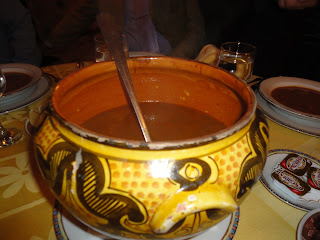Public schools in Morocco seem to suffer from the same types of issues as those in the United States. Inequalities in funding. Differences in achievement based on the socioeconomic level of the parents. Differences in the maintenance of the facilities and the equipment available to teachers and students. Look at the images of the schools below.
This is the outside of a public school in the city of Sale. Everything looked tired. The school needed to be repainted. The garden areas looked as if they were not cared for frequently. A few students were strolling along the promenade, braving the rain. The rest seemed to be huddled in a shelter area near the class buildings. The director did not seem enthusiastic about showing us his school. We met no students. We met a few teachers in a fairly comfortable teachers lounge. It was not an exciting place to visit.
We visited a private school in Sale as well. The school was clean. Although the classrooms seemed crowded with students, there was student work on the walls. The students seemed to be very engaged in lessons. They were on task, attentive and ready to respond to the teacher when there was any request for information made. The English class we saw was of a typical audio-lingual design. The materials were obviously from Great Britain. (Evidently, Great Britain and the United States spar to provide teaching materials to the schools of Morocco.)
Additionally, the staff greeted us and served us milk and dates which is a traditional Moroccan offering of welcome to guests. Later, after a continued tour, we were offered sweets and mint tea in a faculty room, where we were allowed to ask questions of the director of the school and to discuss issues she felt were of consequence to the school.
The school I spent a week studying Lycee Ibn Khaldoun has well kept grounds. The school has been freshly painted. The classrooms, although not extravagant were clean and well organized. The students who attend the lycee are not wealthy, but seemed fairly well off. They were bright, interested in learning and eager to ask questions. The English speaking faculty seemed interested in talking to us. Most of the teachers seemed satisfied with their student progress. The lycee is located next to the regional administrative building. So, perhaps there is an official eye on the lycee.
Our colleagues in Beni Mellal told us that the school they visited had issues with vandalism. It seems that in an effort to force teachers to cancel classes, the students will remove light bulbs, remove electrical wiring, damage windows and doors and more. It is a shame.
Overall, there seems to be a great deal of respect shown to education and to teachers in Morocco. At least this is what I saw. However, there were some teachers who said that there is an issue with student violence against teachers. It is horrible that teachers feel they have to deal with that. It must be unnerving for teachers to have students return to their rooms after a violent altercation. When I asked about this, other teachers said that there are teacher who humiliate students and the students react. I don't know if that can be true in all cases. I wonder if there are not some students who are simply out of control. It is disturbing for teachers to think about. Additionally, it was the female teachers who mentioned this to me. I wonder what the incidence of violence against female teachers compared to male teachers.
It is also interesting to note that we have similar issues in our schools. We are preoccupied with funding. Due to lack of funding, we worry of maintaining our buildings and upgrading our materials and supplies. We teachers are very concerned about student achievement, especially those of us working in impoverished settings. We all seem to be asking the same question, "How do I teach my students what I know they need with the resources available to me?"

























